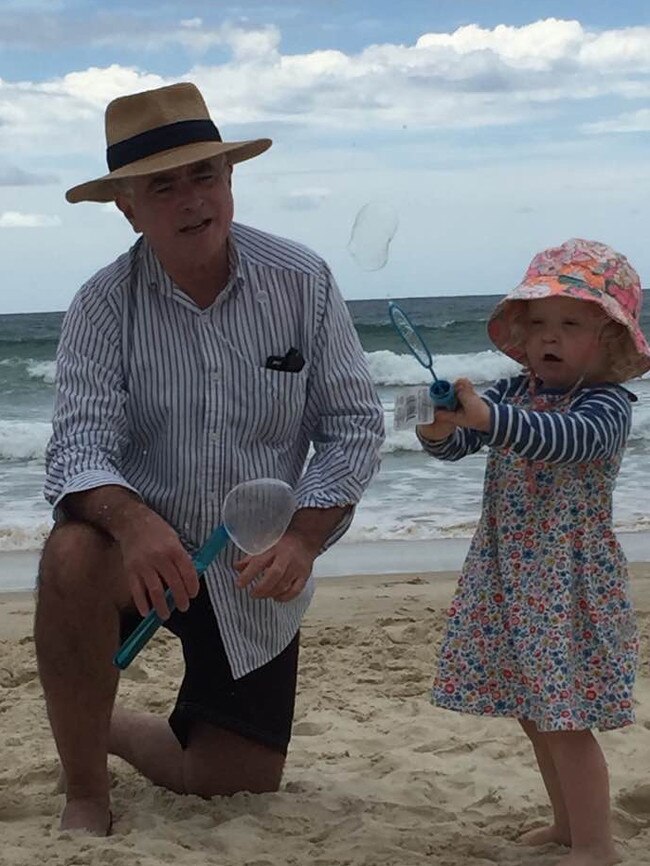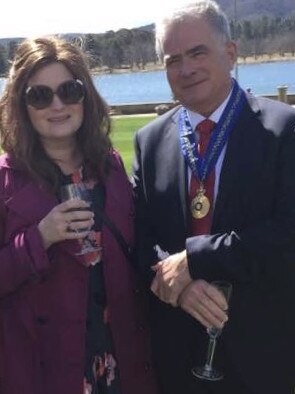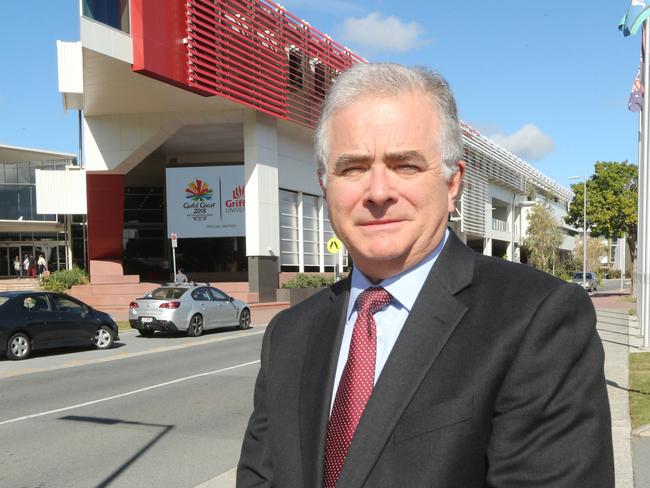PROFESSOR Ian O’Connor could never have known the hour of his exit would be so bittersweet.
After 14 years as the Vice Chancellor and President of Griffith University, taking the campus to head of the class, next month is his last.
While he set his date of departure an astounding six years ago, believing it would provide the university both with security and the ability to formulate a successful succession strategy — both of which have proven true, there is now a far more powerful and personal reason to leave his Griffith family.

His daughter.
At age 34, with an 11-week-old baby, Prof O’Connor’s daughter Caitlin was diagnosed with stage four bowel cancer.
It had already spread to her liver, with specialists speculating she had six months to live.
Instead, three years later, she continues to fight on.
Which means Prof O’Connor knows exactly where his first step away from academia will take him.
“It will be great to be able to spend more time with Caitlin and my beautiful granddaughter Violet,” he says.
THE INTERVIEW: JENNY ROGERS OF SILK ON UPTON
THE INTERVIEW: ABORIGINAL ARTISTS GOOMPI UGERABAH
“She lives in Canberra so we’ll go be with her there more often. I had no idea when I set this date all those years ago that this is where we would be, but it is good timing — in as much as any of this can be termed ‘good’.”

But ever the man of action and education, Prof O’Connor is determined to use this poignant moment as a teachable one.
Caitlin is one of an increasing number of young Australians to be diagnosed with bowel cancer.
GET FULL DIGITAL ACCESS FOR 50C A DAY
Bowel Cancer Australia spearheads the Never Too Young campaign to raise awareness that just between 1990 and 2010, bowel cancer rates doubled in young Australians aged 20-29 years and increased by 35 per cent in those aged 30-39.
“I’ve decided that one of the first things I really want to do is increase awareness about this cancer,” says Prof O’Connor, who encourages anyone of any age who has symptoms to speak to their GP.
“The rate of bowel cancer for young people is growing at a frightening rate. But until it affected Caitlin, I had no idea.

“She doesn’t fit any of the risk profiles. It was only after she had her baby and was in pain that she was checked and they discovered just how advanced the cancer was.
“It’s an awful thing to see your child, especially a young mother, go through this. But she has been so strong and so we will be strong for her. And I know she wants to help others, so that is what I will do.
“I don’t know exactly how, but the timing is right.”
Even in the darkest moments, Prof O’Connor is an eternal optimist.
While he regularly mocks his self-described “Pollyanna tendencies’’, it is this blue-sky dreaming that has enabled his greatest successes, whether personal, professional or civic.
He came to Griffith and the Gold Coast with a plan to transform both, and delivered.
Since 1990, the Gold Coast campus has grown from three buildings, a car park, 1800 students and a small number of enthusiastic staff into the university’s largest campus and a research and teaching powerhouse in its own right. In 2018, Griffith’s Gold Coast campus is home to more than 20,000 students.


In fact, an independent economic study by giant accounting firm Ernst & Young showed the university contributed almost 3 per cent of the city’s economy, supporting in excess of 4000 jobs, with a total economic contribution greater than $700 million a year.
“I did come into this job with some big ideas of what I wanted to do. I could just see the potential of the university and of the Gold Coast. That’s why I moved the VC office down here,” he says.
“In the early days it was a case of saying, ‘oh, we’re going to do this and that’, it was sewing promises but we delivered them all.
“A picture of the campus says it all. We were a small outpost surrounded by bush, now we’re a huge knowledge, technology and health precinct that is central to the city we support.
“You can walk on to the campus any day of the year and it is alive with students and academics.”
As special as Prof O’Connor has been to the city, even being awarded the Companion of the Order of Australia (AC) for his services to the community, it is equally so to him.
He says having studied social work at UQ in the mid-1970s, it was never his ambition to lead a university — but once at Griffith he knew it was the only institution for him.
“I was very lucky in my career, I always landed good jobs at quite a young age. I guess I was in the right place at the right time,” he says.
“Social work was my passion. I worked in children’s protection and juvenile justice, I was consultant to the Royal Commission into Deaths in Custody, and then in 2002 I joined Griffith University as deputy vice chancellor in teaching and learning.
“I knew when I became Vice Chancellor (2005) that this was it for me. I didn’t want to go to another university, this was where I wanted to be.
“We created an environment where talented people would want to be. This campus is a magnet for talented, committed people from around the world.
“Not only do we have (director of Griffith University’s Institute for Glycomics) Professor Mark Von Itzstein but we have many world leading researchers in many fields on campus, like climate change response expert Professor Brendan Mackey and malaria vaccine crusader Professor Michael Good.”

However, Prof O’Connor says there is still plenty of work to be done.
He says one of his greatest objectives has been increasing the tertiary participation rate on the Gold Coast.
“We’ve done a lot of work on participation rates but it is still lower here on the Gold Coast than it is in Brisbane,” he says.
“Is that because people here are not clever enough? Clearly not. Basically it’s about opportunity and historically on the Coast there has been a lack of that due to a lack of university places on offer.
“We have worked hard to increase the places, but you need to have a whole lot of factors to pull people through the system.
GET FULL DIGITAL ACCESS FOR 50C A DAY
“It takes time. Not just a year or five years but 10 years or more. It becomes a generational shift that, yes, university is a possibility and even a probability for most students.
“It’s important not just for those individual students but for the Gold Coast itself. An educated workforce means the city is much more attractive to business.”
Originally from Townsville, Prof O’Connor says he would never be tempted to leave our city.
A devoted resident of Southport, he says he intends to stay and watch the continued transformation of his adopted hometown.
“The light rail, the Commonwealth Games … we are in such an exciting stage of the city right now,” he says.
“Plus, now that I will have more free time, where else would I want to be but the beach?”
He’s not entirely joking, although there are limits to how much free time he will have.
Prof O’Connor is chair of the Higher Education Standards Panel and of the Queensland Art Gallery Board of Trustees.
He is also a board member of Open Universities Australia, Trade and Investment Queensland, the Foundation for Australian Studies in China, and the Foundation for Australia-Japan Studies.
“I may be finished with my full-time career but there will still be plenty on my plate,” he says.
“It is a wrench to leave Griffith, of course. I always wanted to stay as long as I could, without overstaying.
“That’s why I set my departure date six years ago. At the time it seemed very far off in the future and it meant there was a lot of stability and the ability to do forward-planning.
“I also think that there never is a ‘right’ time, you always find there is more you want to do. It’s hard to say goodbye but I know this is what needs to be done — for myself and the university.”
And, of course, for his family.


Add your comment to this story
To join the conversation, please log in. Don't have an account? Register
Join the conversation, you are commenting as Logout
Sharks unveil huge new stadium, $500m mega development
Southport Sharks has unveiled plans for a near-21,000-seat stadium and three residential towers in a massive redevelopment that could reshape the Gold Coast's sporting landscape.
Revealed: All Coast’s options for solving gridlock nightmare
The Gold Coast's population will surge by 350,000 in two decades, but the city's transport blueprint remains in limbo after light rail's dramatic cancellation. FIND OUT MORE